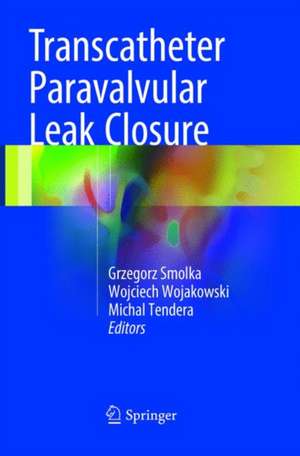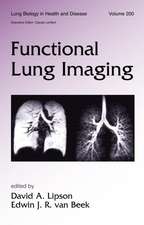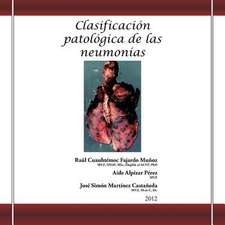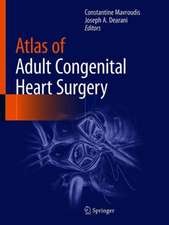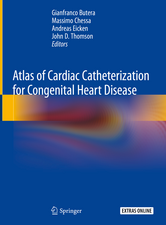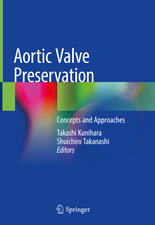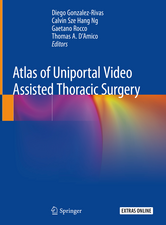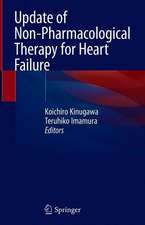Transcatheter Paravalvular Leak Closure
Editat de Grzegorz Smolka, Wojciech Wojakowski, Michal Tenderaen Limba Engleză Paperback – 12 dec 2018
Specific topics covered in this book include the mechanisms of artificial valve dehiscence, with a focus on local anatomical conditions; data on conservative and surgical treatment; qualification for paravalvular leak closure; multimodality imaging techniques; a step-by-step description of access, device selection and implantation; practical tips and tricks for troubleshooting; and the latest clinical data on transcatheter paravalvular leak closure.
The book facilitates the application of contemporary knowledge in clinical cardiology, cardiac surgery,imaging and interventional cardiology in the management of patients with this challenging clinical problem.
| Toate formatele și edițiile | Preț | Express |
|---|---|---|
| Paperback (1) | 331.42 lei 38-44 zile | |
| Springer Nature Singapore – 12 dec 2018 | 331.42 lei 38-44 zile | |
| Hardback (1) | 368.21 lei 3-5 săpt. | |
| Springer Nature Singapore – 8 sep 2017 | 368.21 lei 3-5 săpt. |
Preț: 331.42 lei
Preț vechi: 348.86 lei
-5% Nou
Puncte Express: 497
Preț estimativ în valută:
63.47€ • 65.40$ • 53.17£
63.47€ • 65.40$ • 53.17£
Carte tipărită la comandă
Livrare economică 20-26 februarie
Preluare comenzi: 021 569.72.76
Specificații
ISBN-13: 9789811353888
ISBN-10: 9811353883
Pagini: 182
Ilustrații: IX, 182 p. 95 illus., 80 illus. in color.
Dimensiuni: 155 x 235 mm
Ediția:Softcover reprint of the original 1st ed. 2017
Editura: Springer Nature Singapore
Colecția Springer
Locul publicării:Singapore, Singapore
ISBN-10: 9811353883
Pagini: 182
Ilustrații: IX, 182 p. 95 illus., 80 illus. in color.
Dimensiuni: 155 x 235 mm
Ediția:Softcover reprint of the original 1st ed. 2017
Editura: Springer Nature Singapore
Colecția Springer
Locul publicării:Singapore, Singapore
Cuprins
1. Surgical Aspects of Paravalvular Leak.- 2. The Role of Imaging in Paravalvular Leak Assessment.- 3. Transcatheter Paravalvular Leak Closure - History, Available Devices.- 4. Occlutech® Paravalvular Leak Device (pld).- 5. Echo-Guiding During Transcatheter Paravalvular leak Closure.- 6. Fusion Imaging for Paravalvular Leak Closure.- 7. Transcatheter Closure of Paravalvular Leaks – Procedural Aspects.- 8. Mitral Paravalvaular Leak Closure:the Apical Approach.- 9. Paravalvular Leakage After Transcatheter Aortic Valve Implantation – European Experience.- 10. Transcatheter Management of Tavi-Associated Paravalvular Leak – us Experience.- 11. Complications of Paravalvular Leak Closure.- 12. Summary.
Notă biografică
Grzegorz Smolka, MD, FESC, is Associate Professor at the Department of Cardiology and Structural Heart Diseases, Medical University of Silesia, Katowice, Poland. He is primarily involved in interventional treatment of structural heart diseases in adults, and is a leader in the field of percutaneous paravalvular leak treatment. He is Editor-in-Chief of the Advances in Interventional Cardiology journal, and co-director of the International Summit on Imaging and Interventions in Cardiology (ISIIC). Dr Smolka is author and co-author of more than 50 papers and 3 books.
Wojciech Wojakowski, MD, FESC is Professor and Chair at the Department of Cardiology and Structural Heart Diseases, Medical University of Silesia, Katowice, Poland. He also serves as President-Elect of the Association on Cardiovascular Interventions of the Polish Cardiac Society. His research interests focus on structural heart disease interventions, intravascular imaging and innovative heartfailure and hypertension therapies (cell and gene therapy, renal denervation). He has published over 160 papers and co-authored 5 books. Dr Wojakowski has also received the Thomas J. Linnemeier Spirit of Interventional Cardiology Young Investigators Award (TCT).
Michał Tendera, MD, FESC, FACC is Professor and Senior Consultant at the Department of Cardiology and Structural Heart Disease, Medical University of Silesia, Katowice, Poland, and previous Department Chair. He serves as member of the Executive/Steering Committees of multiple clinical studies. He is member of the Polish Academy of Sciences and former President of the European Society of Cardiology. His research interests include heart failure, different aspects of coronary artery disease, structural heart disease, as well as cell therapy in cardiology. He has published more than 450 papers in peer-reviewed journals and is the editor of 4 books. He serves on the Editorial Board of a number of leading cardiology journals. He is on the Thomson Reuters list of most cited researchers.
Wojciech Wojakowski, MD, FESC is Professor and Chair at the Department of Cardiology and Structural Heart Diseases, Medical University of Silesia, Katowice, Poland. He also serves as President-Elect of the Association on Cardiovascular Interventions of the Polish Cardiac Society. His research interests focus on structural heart disease interventions, intravascular imaging and innovative heartfailure and hypertension therapies (cell and gene therapy, renal denervation). He has published over 160 papers and co-authored 5 books. Dr Wojakowski has also received the Thomas J. Linnemeier Spirit of Interventional Cardiology Young Investigators Award (TCT).
Michał Tendera, MD, FESC, FACC is Professor and Senior Consultant at the Department of Cardiology and Structural Heart Disease, Medical University of Silesia, Katowice, Poland, and previous Department Chair. He serves as member of the Executive/Steering Committees of multiple clinical studies. He is member of the Polish Academy of Sciences and former President of the European Society of Cardiology. His research interests include heart failure, different aspects of coronary artery disease, structural heart disease, as well as cell therapy in cardiology. He has published more than 450 papers in peer-reviewed journals and is the editor of 4 books. He serves on the Editorial Board of a number of leading cardiology journals. He is on the Thomson Reuters list of most cited researchers.
Textul de pe ultima copertă
Representing the first book to offer complete coverage of all related topics, this title provides up-to-date guidance on exactly why, when, and how to perform transcatheter paravalvular leak closure. An international panel of leading experts in the field address the entire spectrum of associated problems, from relevant anatomy, to imaging methods, to implantation techniques, to a comprehensive presentation of clinical data.
Specific topics covered in this book include the mechanisms of artificial valve dehiscence, with a focus on local anatomical conditions; data on conservative and surgical treatment; qualification for paravalvular leak closure; multimodality imaging techniques; a step-by-step description of access, device selection and implantation; practical tips and tricks for troubleshooting; and the latest clinical data on transcatheter paravalvular leak closure.
The book facilitates the application of contemporary knowledge in clinical cardiology, cardiac surgery, imaging and interventional cardiology in the management of patients with this challenging clinical problem.
Caracteristici
Represents the first complete collection of theoretical and practical data on transcatheter paravalvular leak closure, including detailed descriptions of techniques and available devices A comprehensive imaging tutorial prepares the reader for clinical application Describes evolving technology provide the reader with future perspectives
